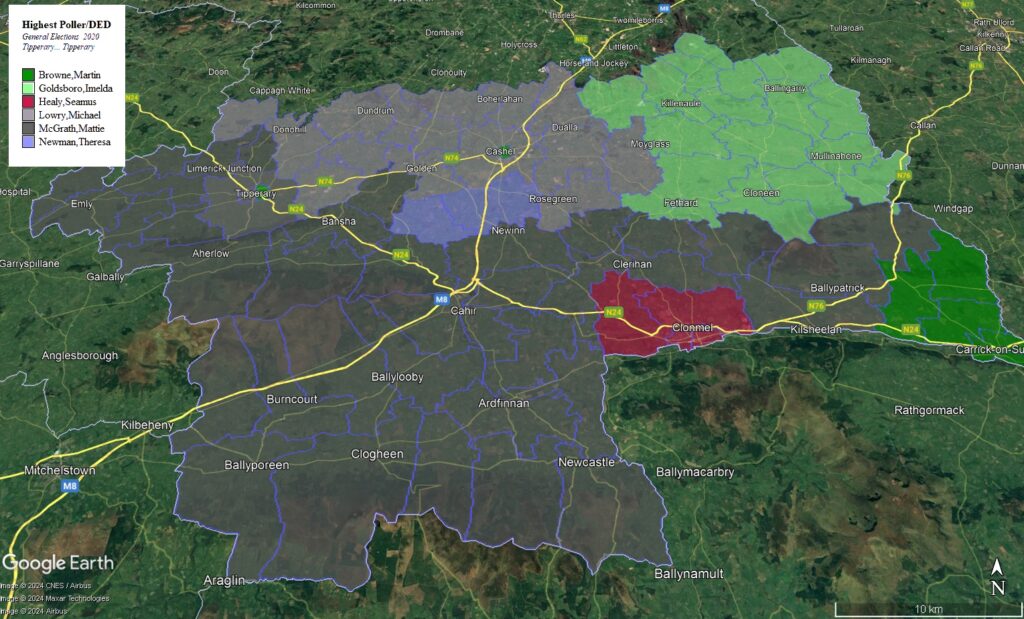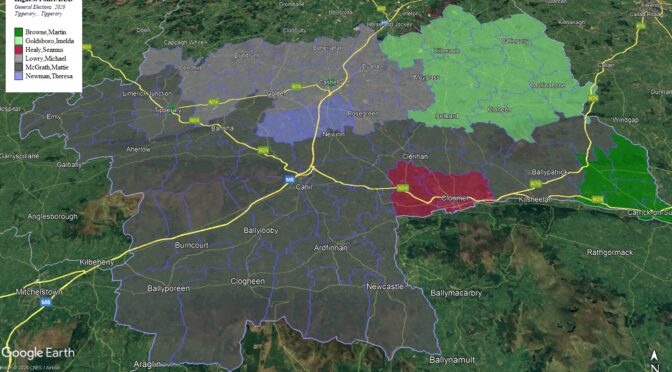HISTORY
Tipperary South has existed – apart from a brief interlude between 2016 and the present – as a stand-alone constituency since 1948. In that election it was a four-seater, and Fianna Fáil were narrowly denied a third seat by Clann Na Poblachta’s Daniel Timoney who had polled less than two thousand votes on the first count.
The margin was even narrower in 1951 when Frank Loughman of F.F. was again denied, this time by Patrick Crowe of Fine Gael who pipped him by just 142 votes. Loughman finally got his revenge when Fianna Fáil finally took three of the four seats in 1957 with Loughman besting Crowe by 123 votes on the last count.
1961 saw the election of Sean Treacy of Labour, who was to hold the seat for 36 years. In his youth Treacy has been associated with the quasi-fascist Ailtiri na hAiseirighe movement, and he clearly retained that streak of Social Conservatism which finally resulted in him being expelled from Labour for voting against a party Family Planning Bill in 1985. He held his seat against erstwhile colleague Michael Ferris in 1987, although Ferris retook the seat for Labour in 1989 when Treacy became Ceann Comhairle for a second period.
For nearly fifty years from 1951, no other party won a seat in Tipperary South outside the Big Three until Seamus Healy of the Workers Unemployed Action Group won a seat in the bye-election occasioned by the sudden death of Michael Ferris. A year later a second bye-election was held due to the death of Fine Gael TD Theresa Aherne – the seat was held by the party although WUAG came second.
In 2007, Martin Mansergh pulled off a major surprise by taking a second seat for Fianna Fáil in the then three seater at the expense of Seamus Healy – Healy was to regain his seat in 2011.
RECENT CONSTITUENCY RESULTS
| YEAR | SEATS | Fianna Fáil | Fine Gael | Labour | Sinn Féin | WUAG | Others | Inds. |
| 1997 | 3 | 37.3% 1 | 24.1% 1 | 16.1% 1 | 16.5% | 6.0%** | ||
| 2000 | 1* | 22.8% | 26.8% | 16.8% | 30.4% 1 | 2.9%** | ||
| 2001 | 1* | 26.5% | 35.9% 1 | 12.9% | 24.8% | |||
| 2002 | 3 | 38.5% 1 | 24.5% 1 | 9.1% | 3.3% | 20.1% 1 | 0.3%** | 4.1% |
| 2007 | 3 | 46.5% 2 | 21.1% 1 | 8.8% | 3.1% | 14.7% | 2.9%** | 2.9% |
| 2011 | 3 | 13.1% | 34.4% 1 | 10.9% | 4.5% | 21.3% 1 | 0.9%** | 14.7% 1 |
| 2016 | 2* | 18.0% | 17.3% | 5.6% | 6.7% | 16.9% 1 | 1.3%** | 33.7% 1 |
| 2020 | 2* | 14.5% | 16.4% | 3.0% | 16.6% 1 | 13.0% | 4.6%** | 31.2% 1 |
NOTES:
* Bye-Elections took place in 2000 and 2001. In 2016 and 2020 I’m using the tallies from the areas that will be in Tipperary South
** Votes for Others are as follows…. 1997 – National Party 6.0%, 2000 – Christian Solidarity Party 2.6% Natural Law Party 0.3%, 2002 – Christian Solidarity Party 0.3%, 2007 – Greens 1.5% Progressive Democrats 1.4%, 2011 – Greens 0.9%, 2016 – Greens 1.3%, 2020 – Greens 4.0% Irish Freedom Party 0.6%
THE 2020 ELECTION
One of the most interesting contests in the soon-to-be-abolished five seat constituency is not the jousting between the various parties and Independents, but rather the tussle over whether the last seat will go to a North Tipperary or South Tipperary candidate.
In 2016, Alan Kelly of Labour (North) bested Tom Hayes of Fine Gael (South) by just over thirteen hundred votes, while in 2021 Jackie Cahill of Fianna Fáil (North) bested Garrett Ahearn (Fine Gael) by fifteen hundred votes.
In 2020, on the first count, Northern Candidates got 50.6% of the first preference votes compared to 49.4% for their southern counterparts. On the ninth and final count, Northern Candidates had 50.4% of the votes, compared to 49.6% for the remaining southern candidates (excluding non-transferables).
However – at every count inbetween – southern candidates actually had a majority of the votes. On the second last count, Mattie McGrath’s surplus went 2 to 1 to the remaining northern candidates (Cahill – FF and Kelly – LAB) over the one remaining southern candidate (Ahearn – FG). Browne (Sinn Féin), also of the south still had a small surplus to distribute but it would have been unlikely to make any substantial difference.
I might come back and have a closer look at this phenomenon later.

Above you can see the poll-toppers for the whole of the Tipperary constituency in 2020 with a white line signifying the coming constituency boundary- notice how far south Michael Lowry’s dominance extends south of the boundary into the area around Cashel.
DEMOGRAPHICS
By my calculations – looking at the 2022 census figures and the tallies – just over half of those who voted in 2020 lived in Rural areas (i.e. Small Village and Rural Polling Stations), just under a third lived in smaller Urban areas (i.e. larger villages and small towns), and the remaining one sixth lived in larger Urban areas (in the case of South Tipp, Clonmel).
The party Support in each of these blocs was as follows :
| TYPE | FIANNA FAIL | FINE GAEL | SINN FEIN | WUAG | OTHERS |
| Larger Urban | 7.9% | 14.3% | 15.8% | 33.5% | 28.5% |
| Smaller Urban | 13.4% | 13.3% | 22.7% | 12.9% | 37.3% |
| Rural | 18.7% | 21.1% | 13.0% | 5.9% | 41.3% |
Fianna Fáil, Fine Gael and Others (mainly Mattie McGrath) all did notably better in rural areas – in Fianna Fáil’s case this is at least partially attributable to the sole Fianna Fáil candidate in the constituency (Imelda Goldsboro) being based in a very rural corner of the constituency. By contrast, the WUAG figures are greatly influenced by Seamus’s Healy’s personal popularity in the only large town in the constituency.
THE CONSTITUENCY REDRAW
The Constituency Commission recommended that the new Tipperary South consist of the entirety of the Cahir, Clonmel and Carrick-on-Suir electoral areas as well as the majority of the Cashel-Tipperary area.
The image below shows the poll-toppers in 2020 in what will be the new Tipperary South in the next election. As noted above, Michael Lowry tops the poll in much of the rural area around Cashel.
It’s actually quite hard to see, but Martin Browne of Sinn Féin topped the poll in Cashel, east Tipperary town as well as Carrick-on-Suir

Interestingly enough, in 2011 – map below – Tom Hayes dominated the entire north of the then Tipperary South, with Mattie McGrath’s dominance confined to his Cahir base. That year Fine Gael were in the hunt for two seats – how times have changed.

The table below shows the effects of the redraw on the votes of the main candidates based in the south of the county.
Mattie McGrath clearly benefits most, as he would have topped the poll on the above numbers. Martin Browne on the other hand would have seen his vote split between north and south, but still would have finished second. Seamus Healy would have seen the sizeable majority of his vote remain within the borders of the new constituency.
Both of the Fine Gael candidates see nearly half of their 2020 vote stay within the borders of the new Tipperary North and can only muster two thirds of a quota between them. Imelda Goldsboro of Fianna Fáil – who is based near the new constituency border – sees over a third of her 2020 vote go North. It should be noted however that Jackie Cahill TD took in excess of two thousand votes in the South.
| Candidate | Party | 2020GE | Quotas | NEW TOTAL | Quotas |
| McGrath | Independent | 9,323 (11.4%) | 0.68 | 7,197 (21.9%) | 0.88 |
| Browne | Sinn Féin | 10,004 (12.2%) | 0.73 | 5,694 (16.6%) | 0.66 |
| Healy | WUAG | 5,829 (7.1%) | 0.43 | 4,463 (13.9%) | 0.55 |
| Ahearn | Fine Gael | 6,206 (7.6%) | 0.46 | 3,336 (9.7%) | 0.38 |
| Goldsboro | Fianna Fáil | 4,082 (5.0%) | 0.30 | 2,445 (7.1%) | 0.28 |
| Newman | Fine Gael | 4,962 (6.0%) | 0.36 | 2.315 (6.7%) | 0.27 |
The net result of the change would (on the 2020 figures) see Mattie McGrath safely elected, Martin Browne of Sinn Féin in a good – though not unassailable – position, and Seamus Healy taking the fight to Garret Ahearn of Fine Gael for the final seat.
